1-Day Nara Itinerary: The Ultimate Day Trip from Osaka or Kyoto

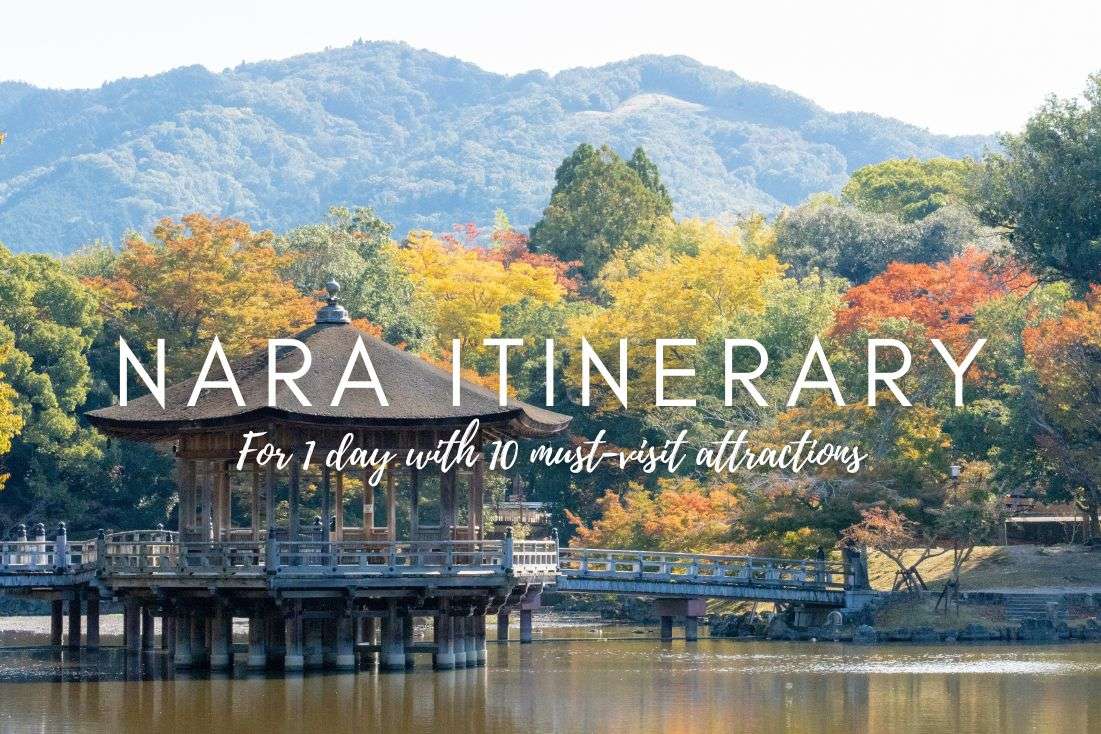
I put together this 1-Day Itinerary in Nara after multiple visits over the years, and I consider Nara one of the best places to visit in all of Japan and certainly in the Kansai Region.
We all know Nara is an epically famous “part” of the Kyoto area, but few know it’s also a UNESCO World Heritage Site and one of the most visited places in Japan—and rightly so.
I know some people want to visit Nara as a day trip from Kyoto, which is the best way of visiting Nara, as I did not find anything else to do for a day.
If you want to laser-focus on just Nara for a very full day, you’ve come to the right travel blog (or if you’re like me, you’ll be able to see everything in 6 hours and then just lounge around having coffee). Because from my research before my own trip, half of the people writing about it couldn’t have visited Nara! The info is just plain wrong. So, welcome, here’s a real guide to Nara from my personal experience of actually traveling to Nara. I can’t believe I need to specify that.
I came to Nara mainly to visit the Todai Ji Temple, the biggest wooden structure in the world, and the biggest bronze Buddha in the world. I will spoil it to you – it is absolutely amazing, but I also found out that there is much more to see in the ancient capital of Japan.
Overview of Nara 1 Day Itinerary: Your detailed trip plan + map!
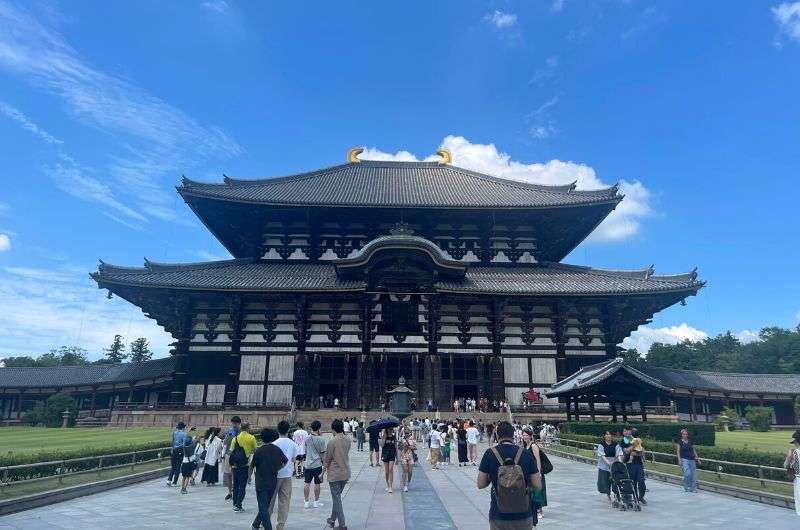
Are you ready for a whole day of exploring Nara?
Here’s how I think you should spend one day in Nara, complete with time spent at each spot, distances, and ticket prices.
All 8 stops in my Nara Itinerary
Day 1, stop 1: Noborioji Park to hang out with bowing deer
Day 1, stop 1: Noborioji Park to hang out with deer
Day 1, stop 2: Kofuku-ji
Day 1, stop 3: Naramachi Quarter
Day 1, stop 4+5: Mt. Wakakusa and optional Kasuga Taisha
Day 1, stop 6: Tōdai-ji, Nara’s top must-see!
Day 1, stop 7: Yoshikien and Isuien Gardens
Day 1, stop 8 (optional): Heijo Palace Site Historical Park
I didn't need an eternity to fall for Nara—10 hours was enough, really—, but the time I spent there was unforgettable. Thanks to the grandiose Daibutsuden (a jaw-dropping temple with a giant Buddha statue inside) and the polite deer population, Nara has a unique vibe.
The Top 10 Places to See and Do in Nara
In order of my infallible, top-notch travel wisdom—because let's face it, I'm the travel guru you never knew you needed. Therefore, I ranked for you the best places to visit in Nara. So if you are in a hurry, you know that you can go to trimming places to see from the last. (certainly not the worst - I would give you a tip not worth visiting.
Don’t miss these attractions in Nara:
- Daibutsuden at Tōdai-ji—The one and only Cosmic Buddha in a big, BIG! wooden temple.
- Naramachi quarter—Nostalgia and coffee in Nara’s old merchant neighborhood.
- The sacred bowing deer in Noborioji Park—They’re all over Nara Park, but this park is like their mothership.
- Tōdai-ji’s Nandaimon Gate—The massive south gate guarded by scary kings.
- Kofuku-ji—This is what it was like to be a really important aristocratic family.
- Mt. Wakakusa—The best view in Nara, with a hike that can be as long as you want it to be
- Everything else at Tōdai-ji—If there’s just one place you visit in Nara (why?!), make it Tōdai-ji.
- Kasuga Taisha—Nara’s protector shrine with millions of lanterns (exaggerated only slightly).
- Yoshikien and Isuien Gardens—Moss garden, pond garden, old garden, new garden, you name it, they’ve gardened it!
- Heijo Palace—It’s where the emperor lived. Better with a car.
You can see the obvious concentration of Nara’s top places in Nara Park. Get a detailed view and list of all the attractions on Google Maps
Oh, and just so we’re clear, most of what there is to do in Nara is in Nara Park. It’s a ton of wow concentrated in one small area, making it the best day trip destination (ideally from Kyoto).
I didn't need an eternity to fall for Nara—10 hours was enough, really—, but the time I spent there was unforgettable. Thanks to the grandiose Daibutsuden (a jaw-dropping temple with a giant Buddha statue inside) and the polite deer population, Nara has a unique vibe.
Where we stayed while visiting Nara as a day trip
Hotel recommendations: Nara is less than an hour’s drive from central Kyoto, so it makes a fantastic day trip. We stayed in Kyoto’s KAYA Kyoto Nijo Castle and had a fantastic experience (gorgeous rooms, warm toilet seats… what’s not to love?!).
If you’d rather stay overnight in Nara, my hotel tips are: MIROKU NARA (no parking) | Sarusawaike Yoshidaya (free parking). Both of these places are just a hop and a skip away from Nara Park, so you’re literally on the doorstep of Nara’s top attractions.
How to Get Around Nara
By car
Parking near the main must-sees in Nara, try this parking lot to the south of Nara Park that charges just JPY 500 per day, or this parking area in the north close to Todaiji (JPY 800 per day). If it seems like too much walking, you can change parking lots during the day, you lazy bum! There are other parking lots, too, so you won’t have trouble finding a spot.
By Public Transport
Located conveniently on the train line from Tokyo to Kyoto—'Tokyo' and 'Kyoto', funny how these names are almost anagrams, right?—Nara is a stop you simply can't skip. Sure, it's squeezed between the ancient grandeur of Kyoto and the cool buzz of Osaka, but Nara holds its own charm… so much so that it’s one of my all-time favorite places in Japan! Nara has just enough must-visit sites that’ll keep you busy for one full day.
Tip: Get my Kyoto – Nara – Osaka itinerary to see how the three neighboring cities can be combined into one epic 4-day trip (with a slightly chiseled down version of this Nara itinerary).
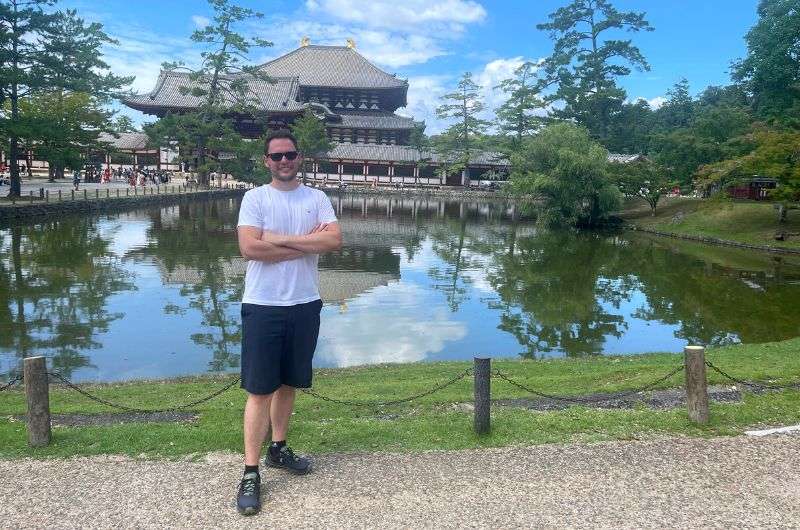
Daibutsuden is one of the highlights of Nara! Keep reading to find out more!
Alright, I think you get that I like Nara, let’s get on with it.
Below, I’ve fit every single place on this list into a similarly unbeatable itinerary for 1 day in Nara. Do it as a long day trip from Kyoto or stay overnight, but make sure to do it because Nara is one of my absolute favorite places in Japan for good reason.
Nara itinerary—stop 1: Noborioji Park to hang out with deer
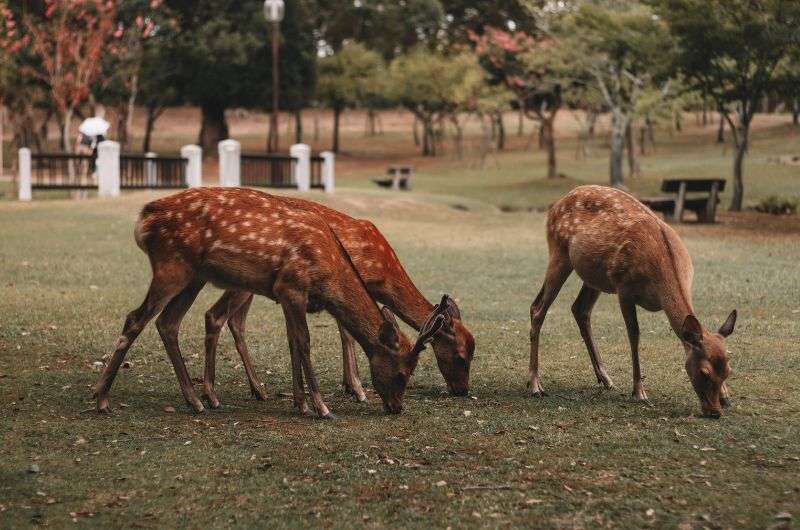
Noborioji Park is the top deer hangout
Time spent here: 30 minutes
Noborioji Park is where we met the most deer, and since getting bowed to by deer is so quintessentially Nara, this is where I think you should start your trip.
You’ll see vendors selling deer crackers for JPY 200 a pack, so stock up if you want to be part of the fun. Make sure to only feed the animals with what you’re supposed to, no improvising! The deer are considered sacred, so just imagine how angry the gods would be if they had a stomachache because of you.
Fun fact: They’ve been selling deer crackers in Nara Park since the 1670s! Also, the packaging is made out of edible materials (+printed with soy ink) just in case the deer eat it. But don’t feed it to the on purpose, and for the love of travel, don’t try to eat it yourself! It won’t hurt you, but just no.
The deer are always there, so don’t worry about looking for the—they’ll find you. They are accustomed to humans and are surprisingly forward with their cracker-finding attempts. Watch your back! You may get a nibble on your bag or back pocket if you aren’t careful or fair with your cracker distribution!
Noborioji Park is part of the Kofuku-ji temple that you’ll be heading to next, so just hang around the deer until you’ve had enough and then move on. Don’t worry, you’re guaranteed to see more deer throughout the day.
Nara itinerary—stop 2: Kofuku-ji
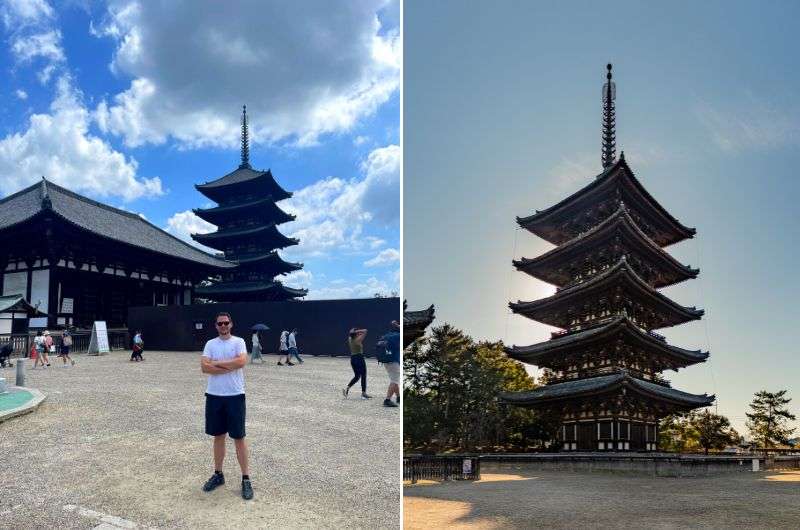
During your visit of the Kofuku-ji temple you will see the second largest pagoda in Japan
Distance from last stop: 0
Time spent here: 1 hour
There’s a lot of construction going on at Kofuku-ji at the beginning of 2024, with some areas completely closed off. The main pagoda is covered up and work will continue until 2031. See official notices for up-to-date information.
Kofuku-ji is the former family temple of the Fujiwara, who were the most powerful aristocratic clan in the Nara and Heian periods. It’s very old—1300 years!—and at the peak of the family’s power, there were about 150 buildings here in total. Today, there’s just a couple of handfuls of them.
You can see the 5-story pagoda from far away—it’s the second largest pagoda in Japan. If only that dark wooden tower could tell the stories from its past!
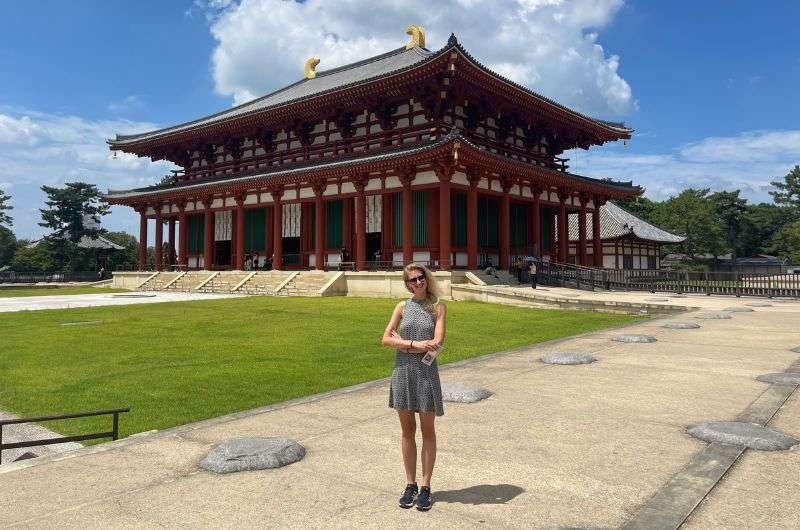
Kofuku-ji temple
You can enter the temple grounds 24/7, which is nice, though if you want to enter any of the buildings, you’ll need to plan a little bit. The recently renovated Central Golden Hall, the Eastern Golden Hall with a big Buddha, and Kofukuji's National Treasure Hall all have their own entrance fees and are open from 9 am to 5 pm. The treasure hall houses a lot of Buddha-related art, and even one of the most celebrated Buddhist statues in all of Japan—the six-armed Ashura.
Later today, you’ll be visiting the gardens close by that used to be where Kofukuji’s priests had their residences.
- Tickets: JPY 300–700 each for Central Golden Hall, Eastern Golden Hall, and National Treasure Hall
- Open 9 am–5 pm
Nara itinerary—stop 3: Naramachi Quarter
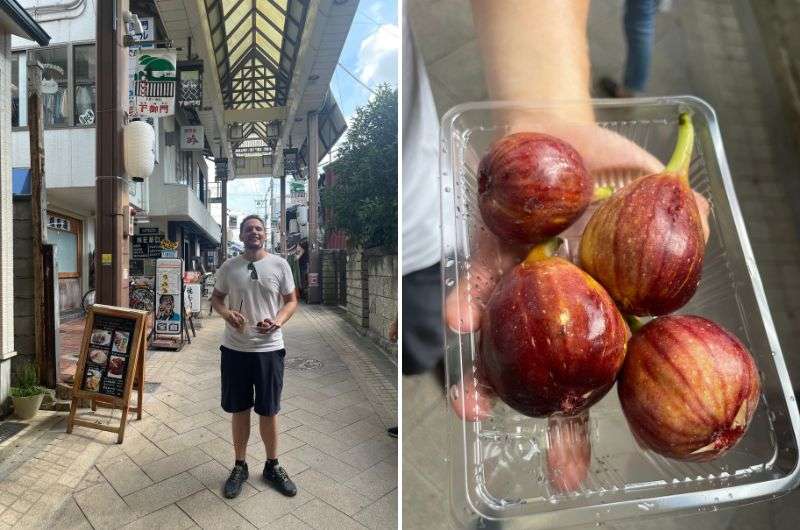
A walk and a bite to eat in the Naramachi Quarter
Distance from last stop: 500 m (0.3 mi), 10-minute walk
Time spent there: 1.5 hours
Walk a little way down Kofuku-ji into Naramachi, the old merchant quarter of the city.
Not only will you walk among the old, narrow wooden buildings and feel like you’ve stepped back in time, but the bonus modern twist is plenty of cafes and bakeries, something you’ll only really appreciate after spending some time in Japan. I think this is where I had my best coffee in Japan, so I have very fond memories. I unfortunately couldn’t tell you the exact cafe if you twisted my arm, so I’ll let you find your own caffeinated treasure. We can pretend it’s on purpose, like a coffee treasure hunt, only without a map and any hints! There are many, many options to choose from.
Props to Naramachi for being as lovely as it is—I tend to hate this type of activity on my travels, where you just wander through narrow alleys or markets and pretend it’s fun. But Naramachi really is.
Nara itinerary—stop 4+5: Mt. Wakakusa and optional Kasuga Taisha
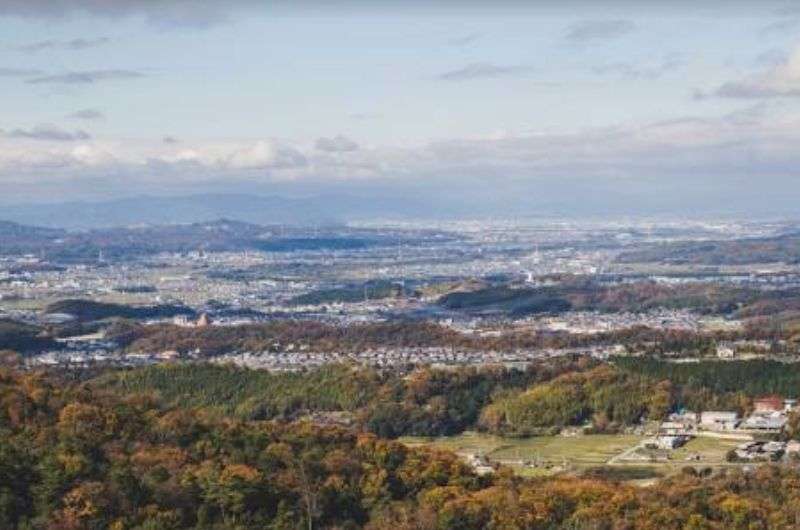
When you climb Mount Wakakusa, this is what you'll see
Distance from last stop: It really depends on where you start walking, but it’s in Nara Park, so you’re never too far
Time spent there: 1.5 hours (or much less if you skip most of the hike and just climb to the viewpoint)
Alright, let’s get a little cardio in, shall we? You can even choose how little that little will be. You can do the entire Mt. Wakakusa hike of a little over 5 km total, see Kasuga Taisha and tons of deer in Nara Park while you’re at it, or drive almost to the end, skip most of the park, the shrine, and the deer, and “hike” the 500 m to the top of the hill in 20 minutes. Oh, and there’s also a third option, where you do half of the full hike. Decisions, decisions! What’s it gonna be?
In the end, the views of Nara from the peak of Mt. Wakakusa are what you’re after. But if you’re a smart traveler, you know that “no pain, no gain” has a lot of truth to it, so you’ll decide to walk the entire distance. That said, this isn’t going to be the hike of your lifetime; it literally is a walk in the park. So, if it’s 6,000 degrees out, or you’re traveling with your grandpa, or you just did the Yoshida Trail on Mt. Fuji, and you just can’t be bothered, choose a shorter version.
Here's what to expect on the full Mt. Wakakusa hike:
You start at the path close to the Nara National Museum Buddhist Art Library (see it on Google Maps), or, alternatively, you can even park your car right at Kasuga Taisha and start there (but remember you’ll then need to return for it). It’s a proper wide path, more like a sidewalk, easy for anyone to conquer.
Kasuga Taisha
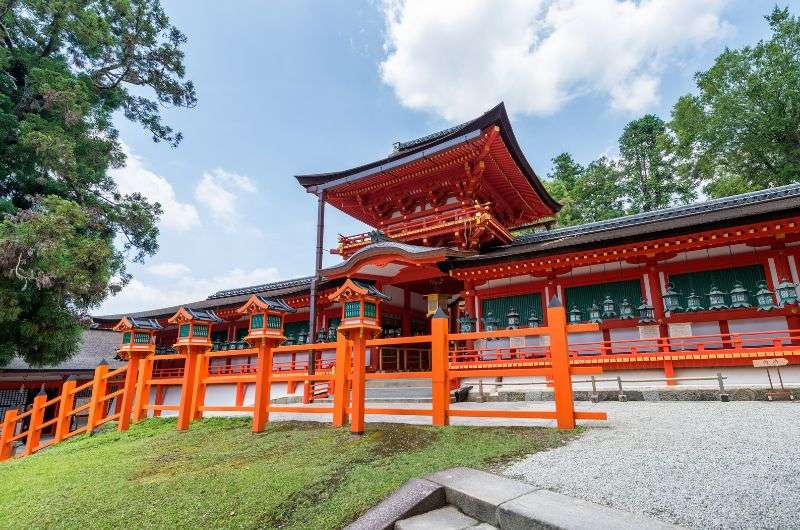
Kasuga Taisha
Kasuga Taisha is a celebrated shrine that is thought to protect the entire city. For me, it was just another shrine to. Japan’s highlights do start feeling a little monotone, and when you’re at your 20th shrine, you can’t help but feel you’ve already seen it.
But let me try to be objective here—there are hundreds of lanterns at Kasuga, all of which were donated by worshippers, which do look very nice. There are stone ones lining the pathways and bronze ones hanging from the edged of the rooftops. I haven’t experienced the biannual lantern festivals where all the lanterns light up, but it may have been that little extra something that would’ve made me love Kasuga Taisha, too. The festival takes place every February and August.
- Temple tickets: JPY 500 for the inner area, otherwise free
Once you walk away from Kasuga Taisha, you’ll finally get to a slightly less pristine gravel path when you reach the stream that you’ll be following part of the way. Most of the trail is slightly uphill through the forest, with a little shrine on the way here and there.
Eventually, you’ll reach the parking lot directly under Mt. Wakakusa and start your final ascent. Honestly, just writing that makes me smile, because I want you to understand that anyone with two legs in anything but terrible fitness can do this, and the word “ascent” just makes it sound like you need hiking gear and willpower to accomplish this. You do not. It’s a hill.
The views continue all the way back down when you take the trail towards Mount Wakakusa base North Gate.
Full Mt. Wakakusa (with Kasuga Taisha) hike stats:
Hike length: 5 km/3 miles (point-to-point)
Hike duration: 1.5 hours
Elevation gain: 200 m/600 ft
Difficulty: Alltrails says moderate, I say easy
Trailhead: Google Maps link to trailhead. Or, if you just want to skedaddle up to the peak quickly, park near it for free

You can find this map on Alltrails.com, just without my fancy labels
Tip: If you wanted a medium version of this hike, you could start and end at the Mount Wakakusa base North Gate (there is parking there for JPY 1000) and make it an out-and-back trip for a total of 3 km (1.8 mi) hike. You’d still get all the views, a bit of exercise, but skip the forested portion.
Nara itinerary—stop 6: Tōdai-ji, Nara’s top must-see!
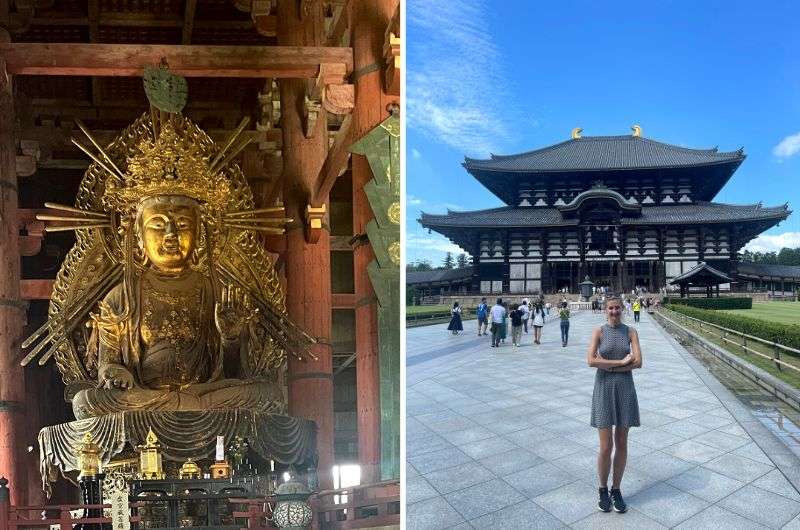
The big Buddha statue in Todai-ji temple is definitely a must-see!
Distance from last stop: 1 km (0.6 mi), 15-minute walk (from Mt. Wakakusa North Gate to Nandaimon Gate)
Time spent there: 1–2 hours
Finally, the top must-see in Nara: Tōdai-ji, one of the most historically important temples in all of Japan. History nerds like me will eat this place up! But also, deer!
Tōdai-ji was originally built in 752 when Nara was the imperial capital. Its biggest claim to fame is the very large, wooden temple called Daibutsuden (Big Buddha Hall). That thing blew me away by just how massive it is, even more than any of Europe’s cathedrals (ok, maybe the ones in Palma de Mallorca and Sevilla top it). Daibutsuden is roughly 50 m (180 ft) long, wide, and tall.
The Buddha inside is supposed to be the “cosmic Buddha”—what a name, huh?!—who created the universe and all of the other Buddhas after him. He’s a big fella! You can try to reach enlightenment by attempting to squeeze yourself (or maybe your very small child) through the hole in the pillar close to the Buddha, which is the same size as the statue's nostril. Good luck and don’t get stuck. Also, how does “cosmic Jan” sound? I may need to rename myself.
Until the end of the 20th century, Daibutsuden was the largest wooden building in the world. It had to be rebuilt, saved, and reconstructed several times due to wars. Nowadays, it’s a little more than half the size of the original—can you imagine what the original must’ve looked like?! The reason it’s smaller now is mainly because of the ginormous amount of cedar wood needed to build it. Despite clearing entire forests, traveling hundreds of kilometers, and building over 100 river dams, there just wasn’t enough wood they could get for this huge building. I’m not lying when I say it’s massive!
But don’t just run straight to Daibutsuden, there’s one national treasure right at the entrance—the Nandaimon Gate. It’s an imposing gate with two angry king statues guarding the entrance.
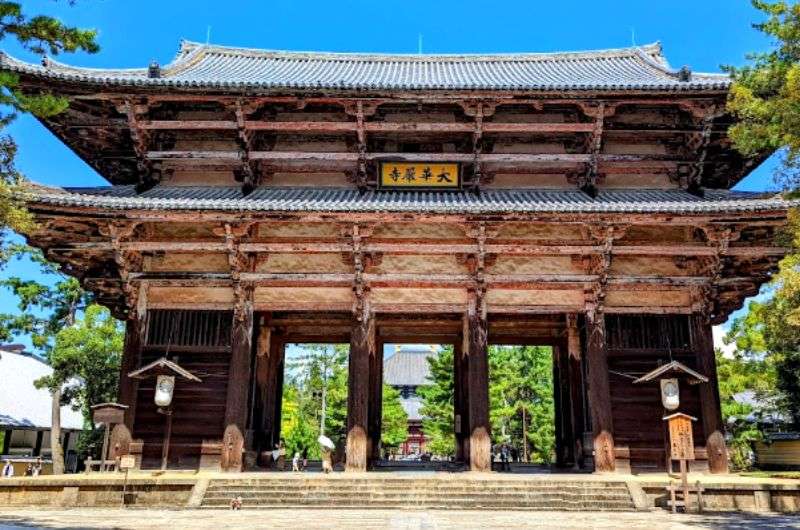
The Great South Wall
Deer warning: It’s not just the kings watching your every move, the deer at Tōdai-ji aren’t stupid and know what they want! You'd better have some deer crackers on hand (or at least clearly show them that you aren’t hiding any). They can get feisty if you’re teasing them or when they’re trying to figure out if you’re carrying anything of interest to them.
Hidden gem in Nara? There are many smaller buildings on Tōdai-ji’s grounds, so make sure to take a good look at them. Don’t skip the ones up on the hill on the east side for sweeping views of the temple and Nara. Hokkedo and Nigatsudo are two beautiful wooden temples with terraces that you can stare down from, kind of like a miniature Kiyomizu-dera!
Get a free English guide on the spot (human, not brochure) if you’d like a more complex understanding of the temple’s significance.
- Tōdai-ji official website
- Temple tickets: JPY 600
- Open daily 7:30–5:00 pm
Nara itinerary—stop 7: Yoshikien and Isuien Gardens
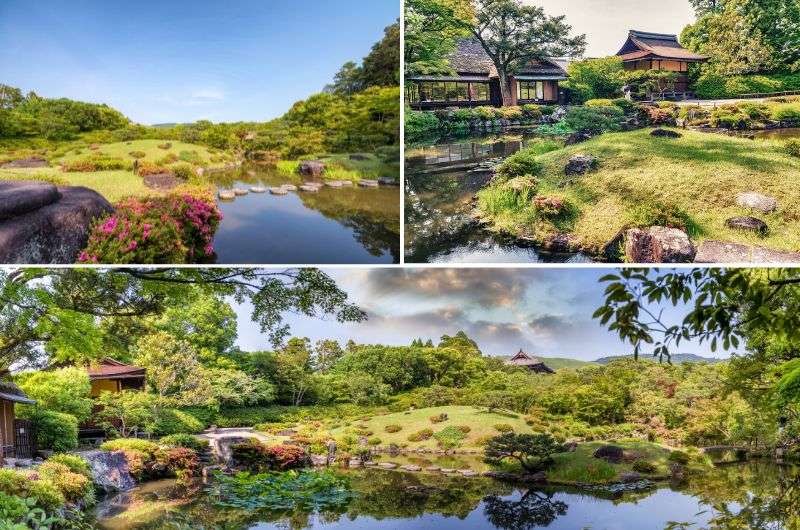
Japanese garden show in Yoshikien and Isuien Gardens
Distance from last stop: right past the bus parking lot outside of the Nandaimon Gate of Tōdai-ji
Time spent there: 30 minutes–1 hour (depending on whether you see both gardens or just one)
Japan isn’t just temples and shrines (though you will start to feel like it is very quickly), it’s also Japanese gardens! Lots of them, everywhere, all the time. They are so nice and serene, it’s almost disgusting, haha. At the Yoshikien and Isuien Gardens, right outside of Nandaimon Gate, you’ll get to see several types of Japanese gardens all in one spot.
Yoshikien Garden is built in the place where the priest residences of neighboring Kofukuji once stood. It’s not very big despite having three separate areas: the moss garden, where the ground is covered in moss, a pond garden (you can surely guess what you’ll find there), and the tea ceremony garden with a tea house. It’s interesting to see the differences between the three, and if you manage to visit at a time that’s less busy, it has a very peaceful atmosphere.
Isuien Garden, just across the river from Yoshikien, is the larger of the two and gets to use Tōdai-ji’s Nandaimon Gate as part of its background. Maybe that’s why they dare charge the relatively steep entrance fee of JPY 1200. The front garden is much older than the rear garden, and both have teahouses scattered throughout. We thought the staff was very friendly and even gave us a little introduction to Japanese gardens (in perfect, i.e., easy-to-understand English!).
If you’re running out of time, I can tell you that I have a slight preference for Yoshikien Garden over Isuien Garden. It’s compact, it gets the job done efficiently with 3 gardens in one go, and if you don’t crave extra garden time, it’s certainly enough.
- Tickets: JPY 1200 for Isuien Garden, Yoshikien is free
- Isuien is closed on Tuesdays and closes at 4:30 pm, Yoshikien is open daily until 5 pm
Nara itinerary—stop 8 (optional): Heijo Palace Site Historical Park
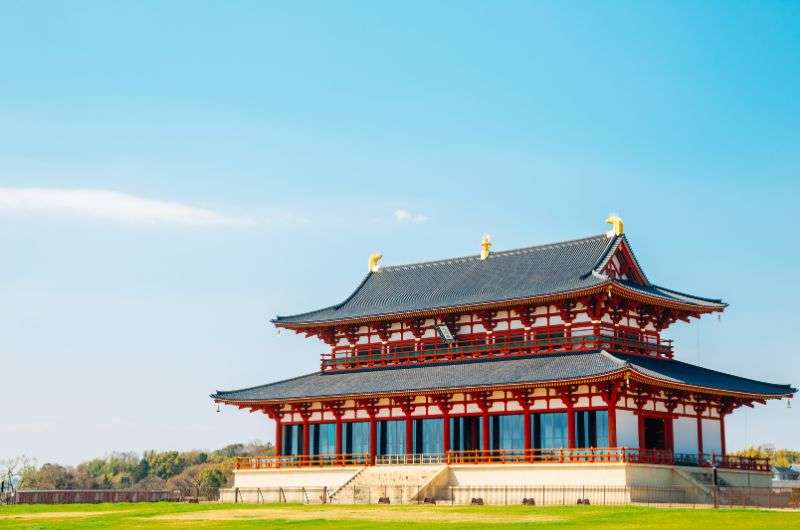
Heijo Palace is located in the middle of an empty field, which seems a bit strange. But it hides a lot of interesting things that you don't want to miss at the end of your day in Nara
Distance from last stop: km (0.8 mi), 20-minute walk
Time spent there: 1 hour
You can consider your 1-day Nara itinerary to be done and head back to your hotel now and start getting excited about dinner—I always am! OR, you can smash out one more stop in Nara: Heijo Palace. You’ll need a car to get there, because it is the only tourist attraction on this itinerary that isn’t in or near Nara Park. There’s a parking lot to the south of the palace.
This extra stop will only be possible if you can get there in time: most of the buildings close around 4:30 pm. Check the official website for details.
You’ll feel like you’ve found a hidden gem in Nara, because despite it being a typical palace of typical Japanese architecture, it’s located on a vast and largely open and empty field—kind of strange and definitely not typical! No Japanese gardening, not many statues, not much of anything… the grounds were used to grow rice, so it’s really a field. But it’s a UNESCO heritage site, so there’s much more than meets the eye.
Rent a bicycle and take a peddle around the grounds for a slightly different Nara experience.
Heijo Palace used to be the emperor’s residence and the place of government buildings when Nara was Japan’s capital back in the 700s. None of the buildings are originals, but they did their best with the historical reconstructions, and some museums showcase the importance of the palace.
The biggest building at Heijo Palace is Daigokuden, the Former Audience Hall (there was also a “latter” audience hall, the ruins of which are close by). Check out the animals on the ceilings, they represent the animals of the lunar calendar and the 4 compass directions.
There are 3 other reconstructed buildings on site, as well as the only place that doesn’t scream ‘field’, the East Palace Garden. You’ll find tourist facilities such as a restaurant, an info point, and an observation deck at Suzaku Hiroba, a square by the Suzaku Gate (the one you’ll enter through from the parking lot). Check out one of the several museums and exhibition halls, each in a different area of the palace grounds, mostly showcasing artefacts from the Nara period and from the excavation efforts going on at the palace.
- Heijo Palace official website
- Free entry
- Last admission to most buildings is at 4 pm
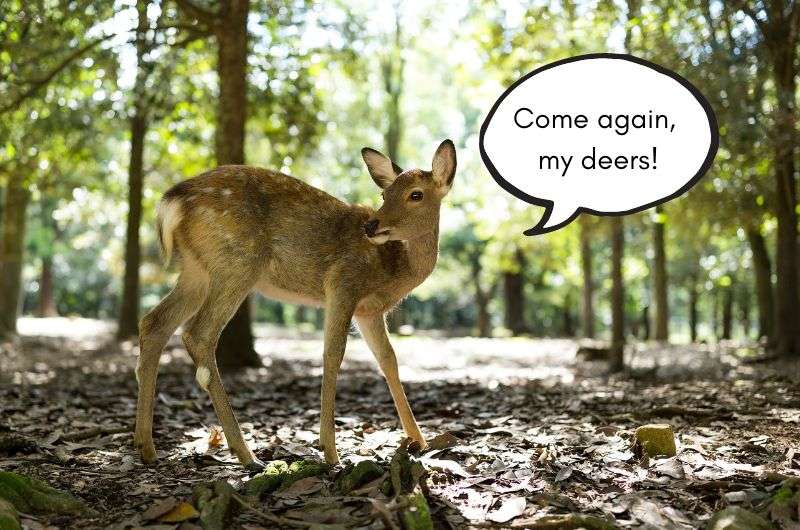
There, you’re done! You’ve seen Nara’s top places, you’ve walked more than you expected to, and you fed way too many deer along the way. But in the end, you (and those deer!) will walk away happy. A day well spent. Get back to your hotel (again, we loved it at Kyoto’s KAYA Kyoto Nijo Castle, but you could try MIROKU NARA or Sarusawaike Yoshidaya if you’d rather crash for the night right there in Nara.
Is one day enough for Nara?
One day is ideal for Nara. Before I went, I saw all these travel blogs recommending 2 days, and I’m here to tell you that a day trip from Kyoto is all you need. It’s a really nice place, but unless you live in Japan or have all the time in the world, 1 day in Nara is totally enough to see its highlights. We spent an entire day there and honestly, the last 3 hours were spent just wandering.
Should I drive or take the train to Nara?
I read time and time again how terrible the parking in Nara is and that we should opt to take the train instead, but guess what? The pseudo-bloggers are wrong again! Parking in Nara’s city center is easy—loads of parking garages and cheap parking fees. And parking by the main sights isn’t any trouble either, plus the top spots are all in one area, so you’ll be doing mostly a lot of walking between the sites. We paid JPY 1000 for parking for our full day in Nara (about USD 6.50), so go ahead and take your car to Nara. They’re ready for you.
Why are there so many deer in Nara?
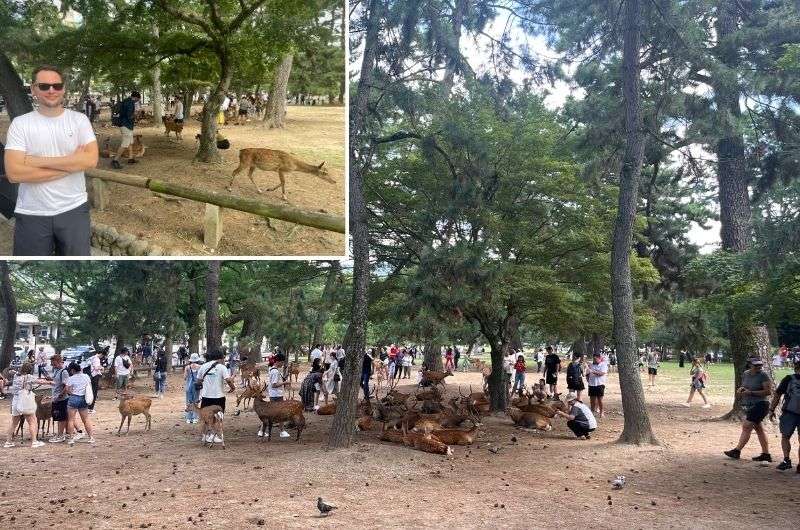
The sacred deer in Nara
The sika deer living in Nara Park—all 1,400 of them!—are considered sacred because of a legend where the gods arrived in Nara riding white deer. The furry creatures in Nara aren’t white, but they sure are cute! You cannot go to Nara without trying to get a deer to bow to you (offer them only the crackers that you can buy in many spots around the park). They’ve learned to bow their heads, though when the competition gets tight or the deer-to-human ratio is off, they can get a little pushy.
Luckily, they get their antlers cut in the traditional antler-cutting ceremony. It has existed since the Edo period so that humans and animals could live together in peace (though I’m not sure what the deer think of it!).
The deer are such a huge part of Nara that people have them as bumper stickers, and they’re even the city’s official symbol. Oh deer! I dare you not to buy anything deer-related when visiting Nara!
Tip: If you’re around in mid-July, you may be able to witness the Roku-en deer enclosure near Kasuga Taisha Shrine, where all the new baby deer of the year are presented to the public.
Where can I see deer in Nara?
Basically everywhere you go in Nara Park, you’ll see deer. You’d have to be blind to miss them. You may even get sick of them, because you’ll never be able to escape the feeling that you just don’t have enough crackers for all of them. And they’ll give you puppy (fawn?) eyes and make you feel guilty. We saw the largest concentration of deer in Nara’s Noborioji Park, near Kofuku-ji.
When’s the best time to visit Nara?
The best time to visit Nara is fall or spring. Trust me, I've been a human torch under the summer sun there, and I'd rather not replay that experience. Summer in Japan is just relentless heat. I'd aim for April–May or September–October for the best Nara trip. I'm not the kind to chase after pretty pink cherry blossoms, but hey, they are a nice perk of visiting Nara in spring. And fall? It's like a paintbox explosion—way more than the one-note green of summer. So, unless you have a thing for sweaty adventures, skip the summer and hit Nara when it's not a giant oven. Seriously, why did I go in August again?
This post contains affiliate links. I earn a small commission if you make bookings through my links, at no additional cost to you. Thank you for your support!


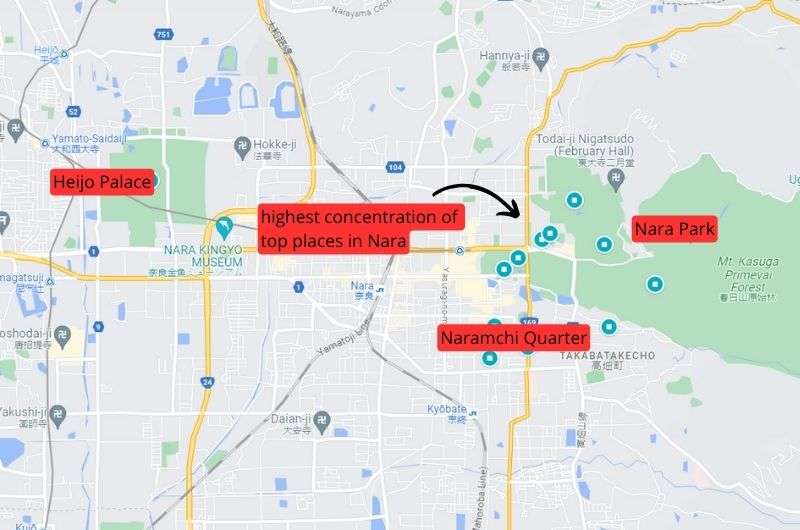
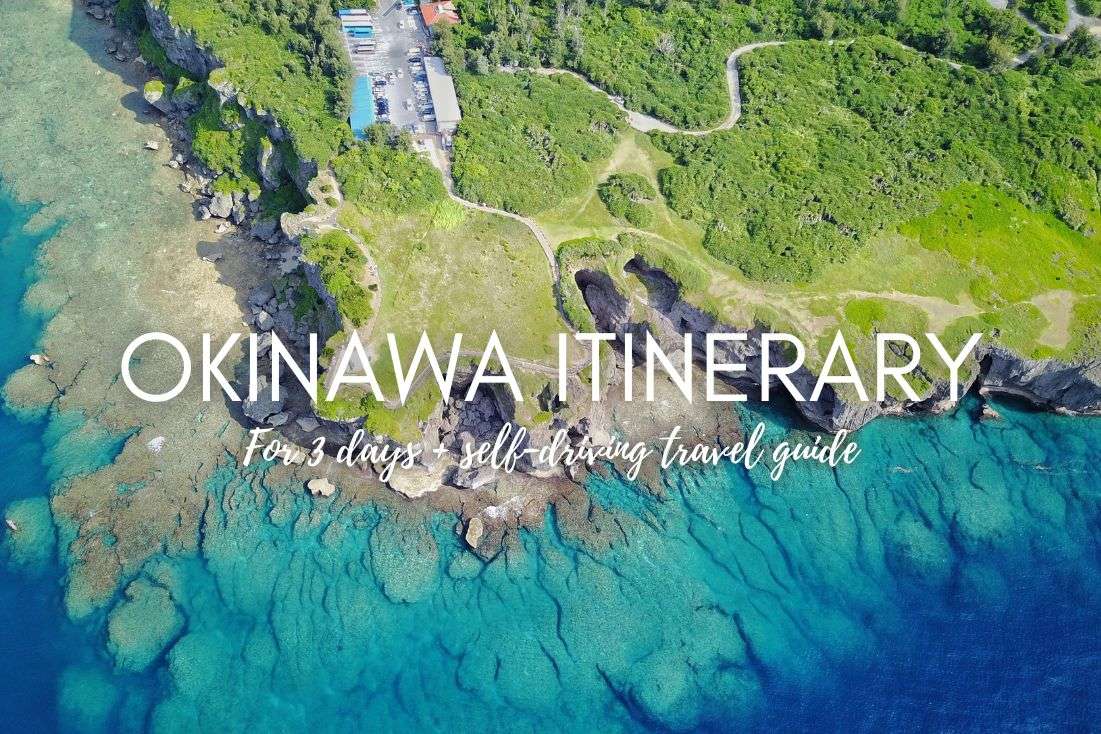
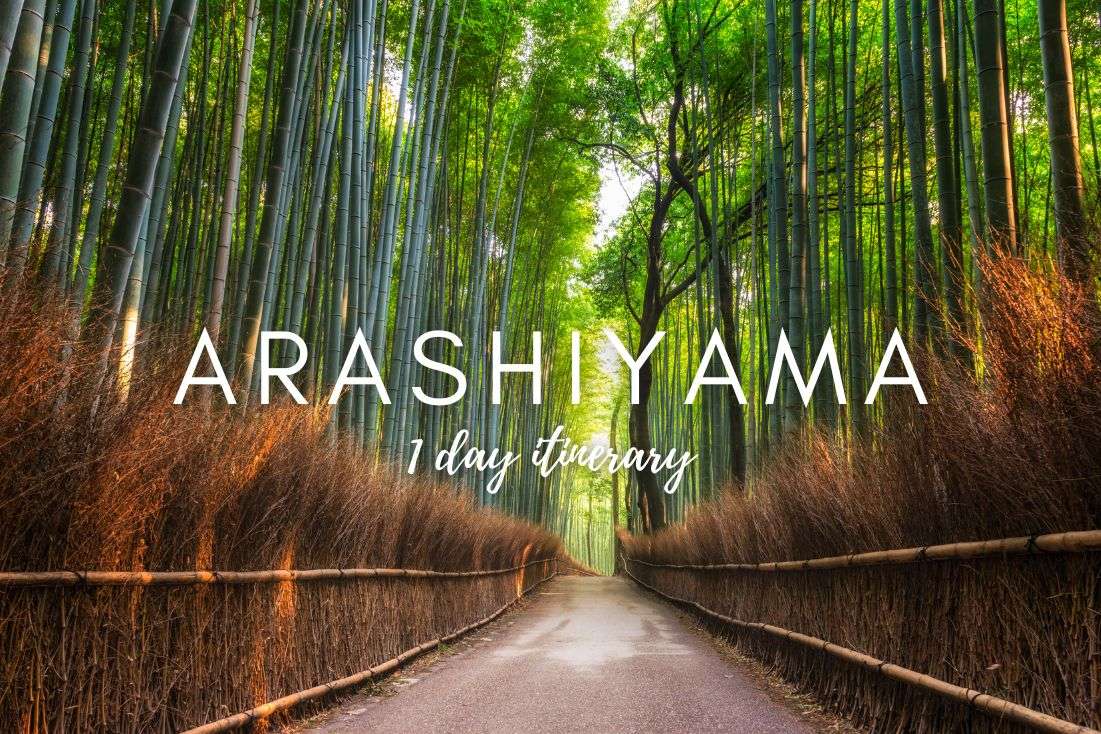
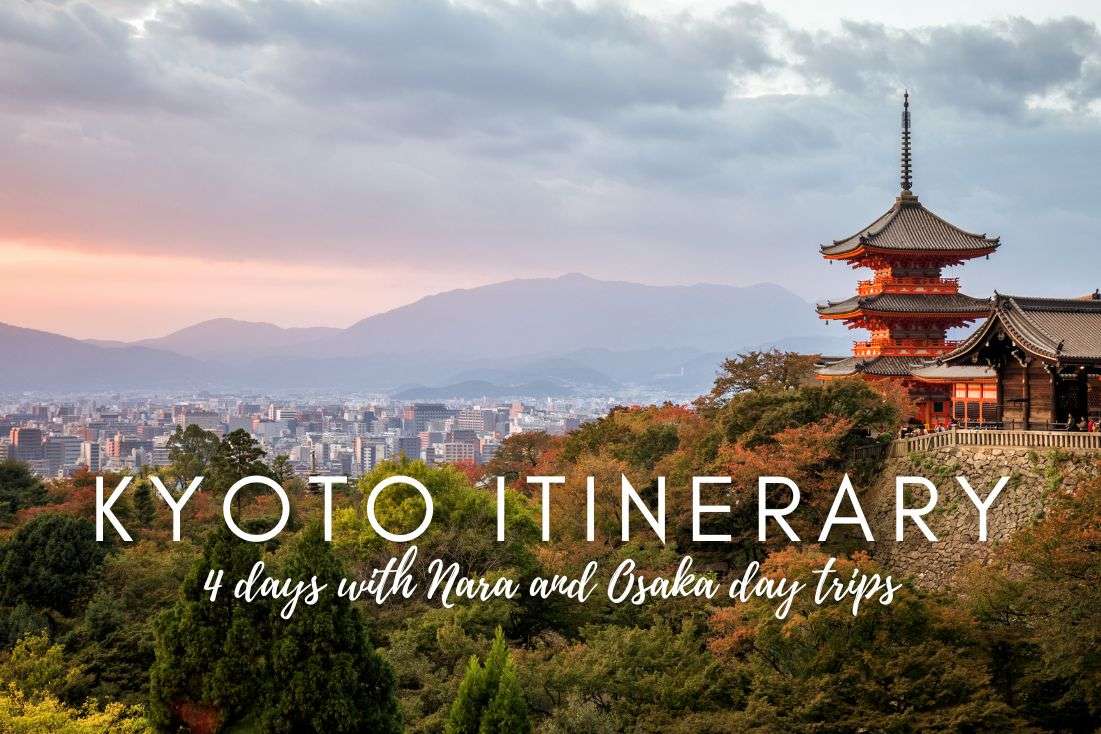





Comments | Thoughts? Give us a shout!